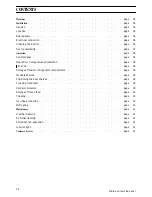
38
OPERATION
Control panel
A.
/
O
pilot light
C.
Thermostat knob
B.
/
O
knob
D.
Operating pilot light
3
4
A
B
C
D
Operation - Temperature adjustment
After cleaning the appliance’s interior, connect the
plug to the wall socket. Pilot light (D) comes on.
The temperature inside both the refrigerating and
freezing compartments is regulated with the
thermostat knob (C).
Start by using a medium setting and then, later,
select the thermostat position most suitable for
your requirements.
The temperature is adjusted automatically and may
be increased (less cold) by turning the knob towards
the lower settings or may be decreased (more cold)
by turning it towards the higher settings.
The correct position, however, must be selected by
taking into account that the internal temperature
depends on the following factors:
room temperature;
the number of times the door is opened;
the amount of stored food;
the location of the appliance.
The operation is interrupted by turning the control
knob until its pointer coincides with symbol «
O
».
Important:
When the thermostat is on the maximum
cold setting and the room temperature is particularly
high, the appliance may run uninterruptedly with
consequent frost formation on the back wall of the
refrigerator compartment. In such a case it is
necessary to set the thermostat on a lesser cold
setting so as to enable automatic defrosting to take
place and consequently save electric energy.
/
O
knob
With a room temperature below +14
°
C the
refrigerator compartment may not function
correctly. To ensure a correct operation even with
low room temperatures, the appliance is provided
with an additional heating element whose switch is
located on the control panel (B). If the toom
temperature is lower than +14
°
C it will be
necessary to turn knob (B) to the « » position. The
relevant pilot light (A) comes on.
Storage of foods in refrigerator compartment
To achieve the best results with the refrigerator
compartment, you should follow some very simple
rules:
Do not put warm foods or evaporating liquids in the
refrigerator;
cover or wrap foods (particularly if they have a
strong smell or contain aromatic herbs).
Please note:
Do not place foodstuffs and paperbags
etc. in contact with the evaporator plate at the rear
of the refrigerator compartment as this can lead to
impairment of the operation of the refrigerator.
In addition, food should be positioned inside the
refrigerator compartment as indicated in the figure
that is given below:
1.
Cold cuts, cheese, butter, milk
2.
Meat and fish
3.
Fruit and vegetables.
In this position, fresh meat can be stored for 1-2 days at most.
Further hints for getting the best out of your
refrigerator are the following:
Cooked food, cold dishes, jellies etc., should be well
covered.
Fruit and vegetables should be washed before being
stored.
Raw meat (all types, including poultry) should be
stored in plastic bags.
D078
1
2
3



























